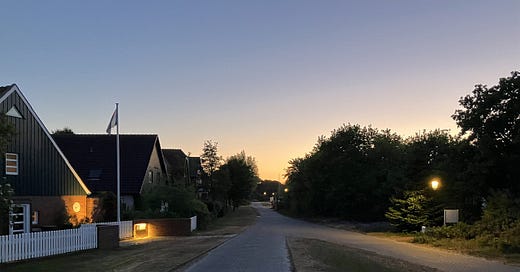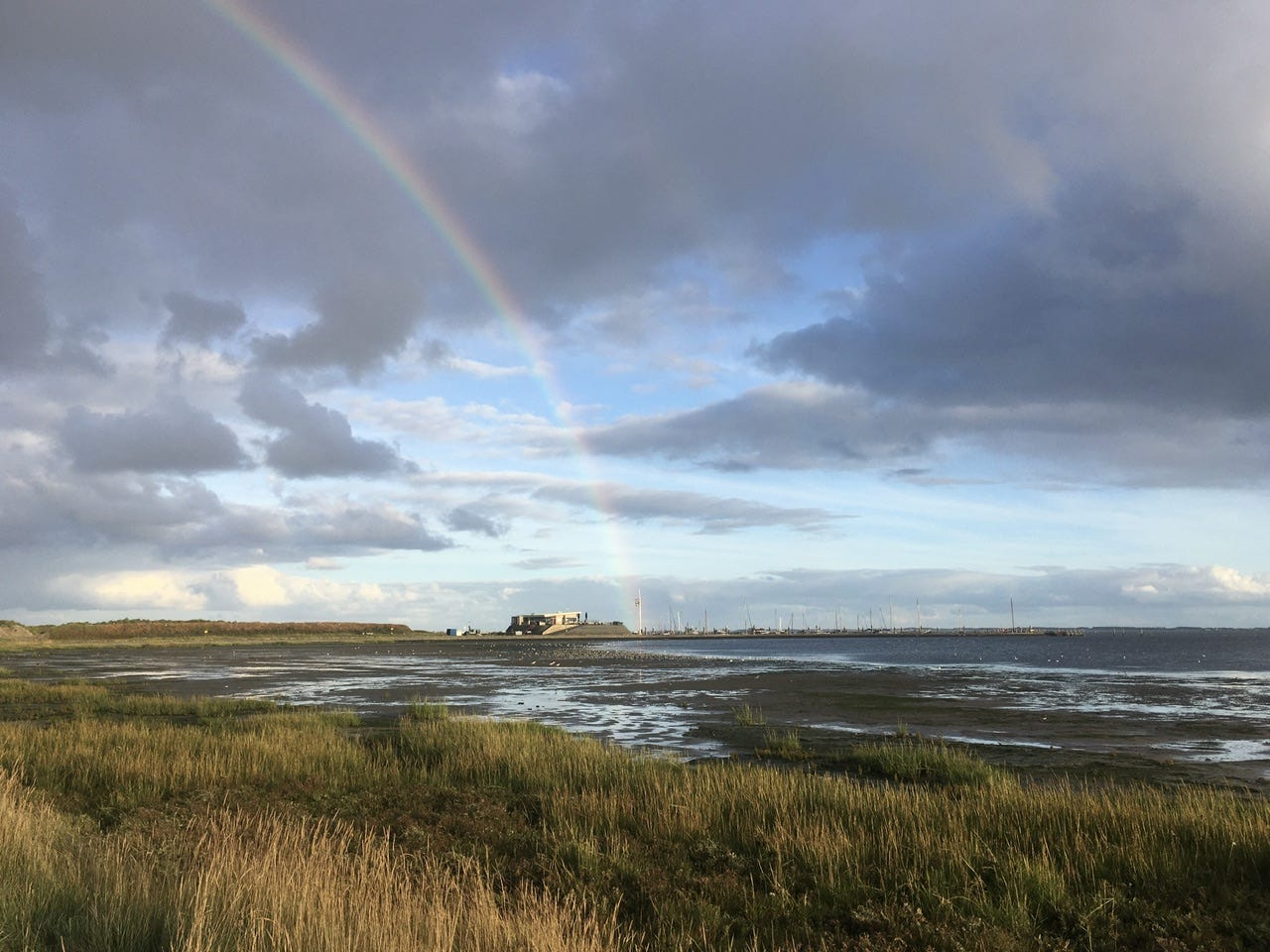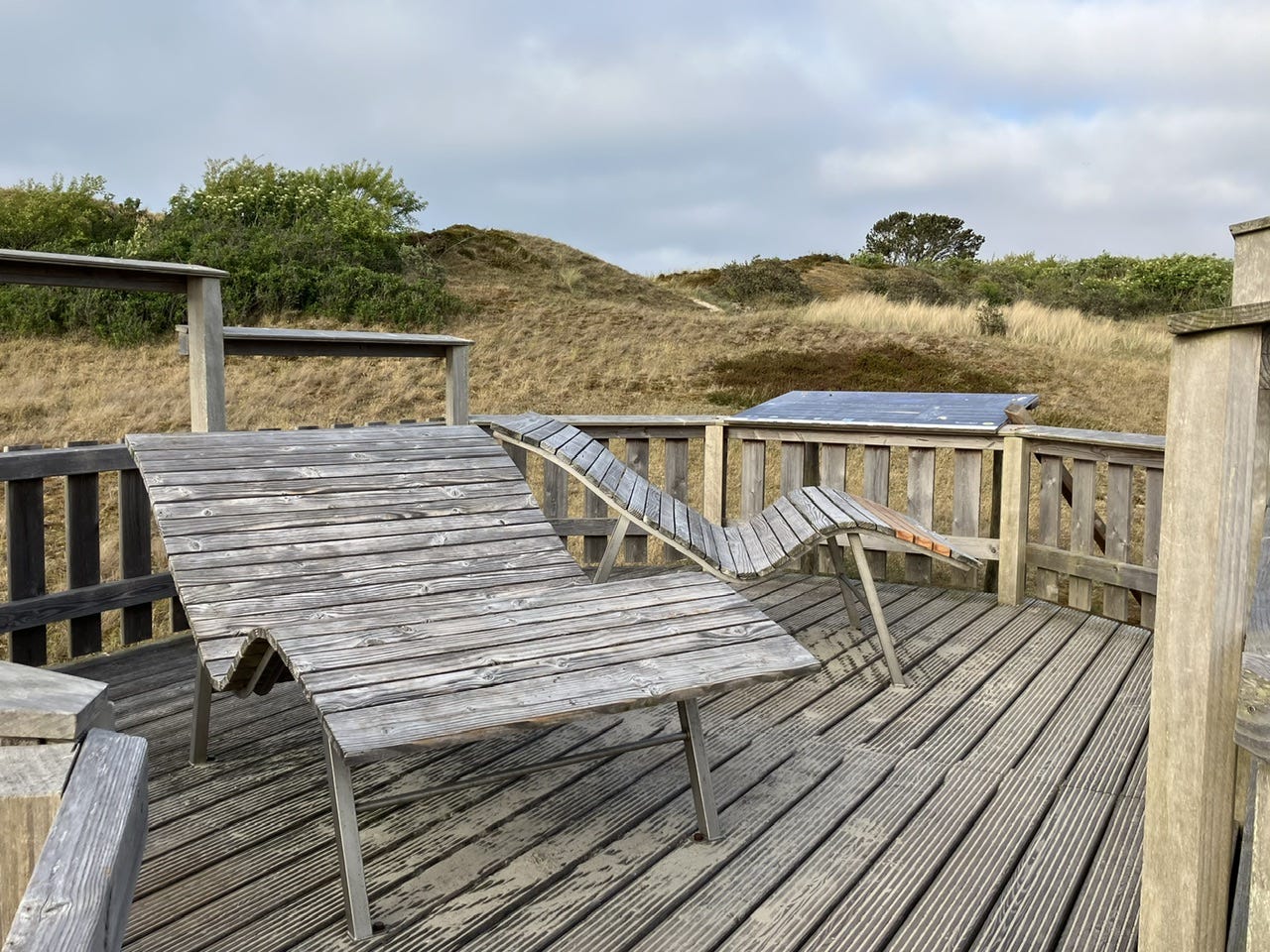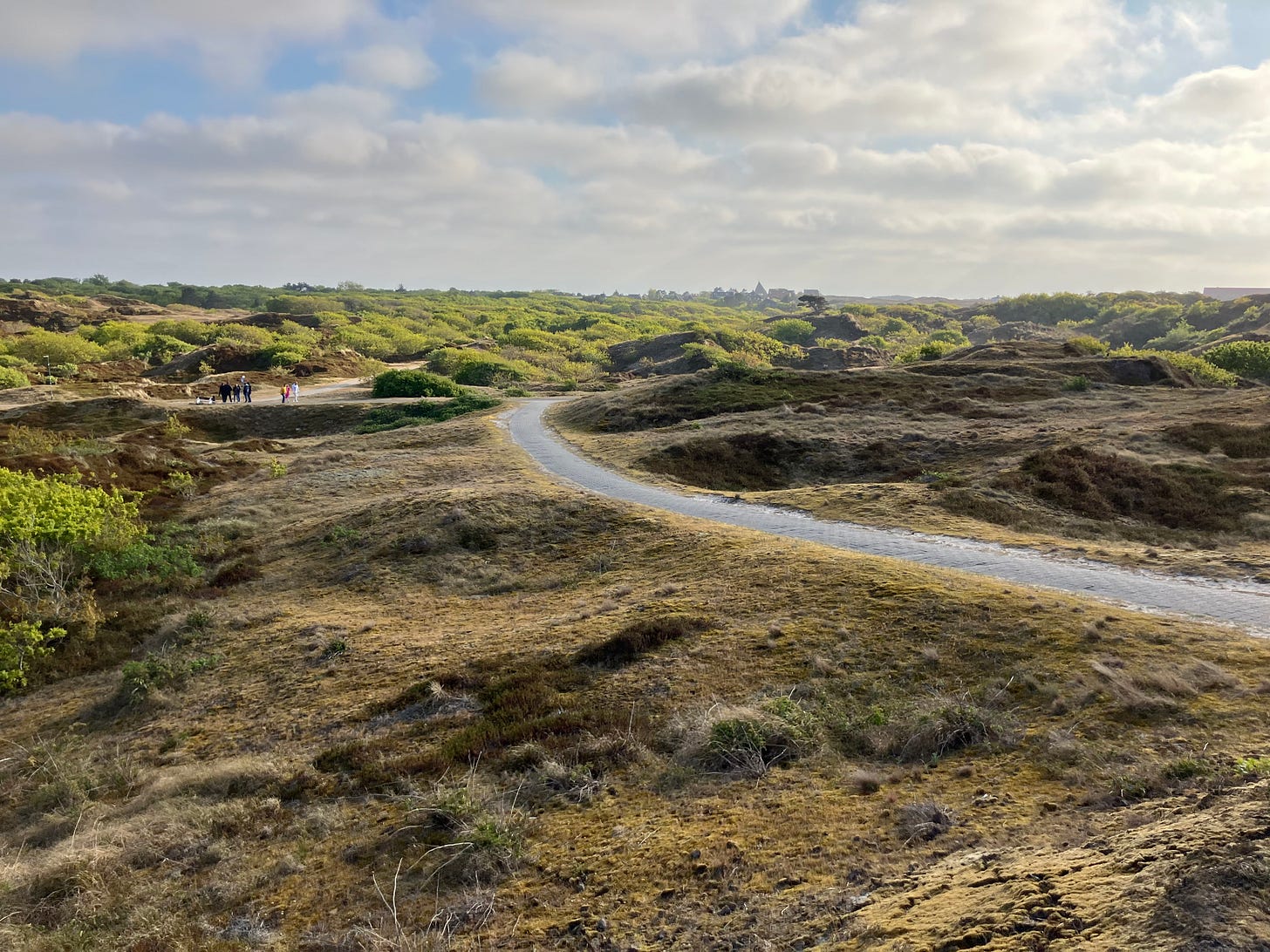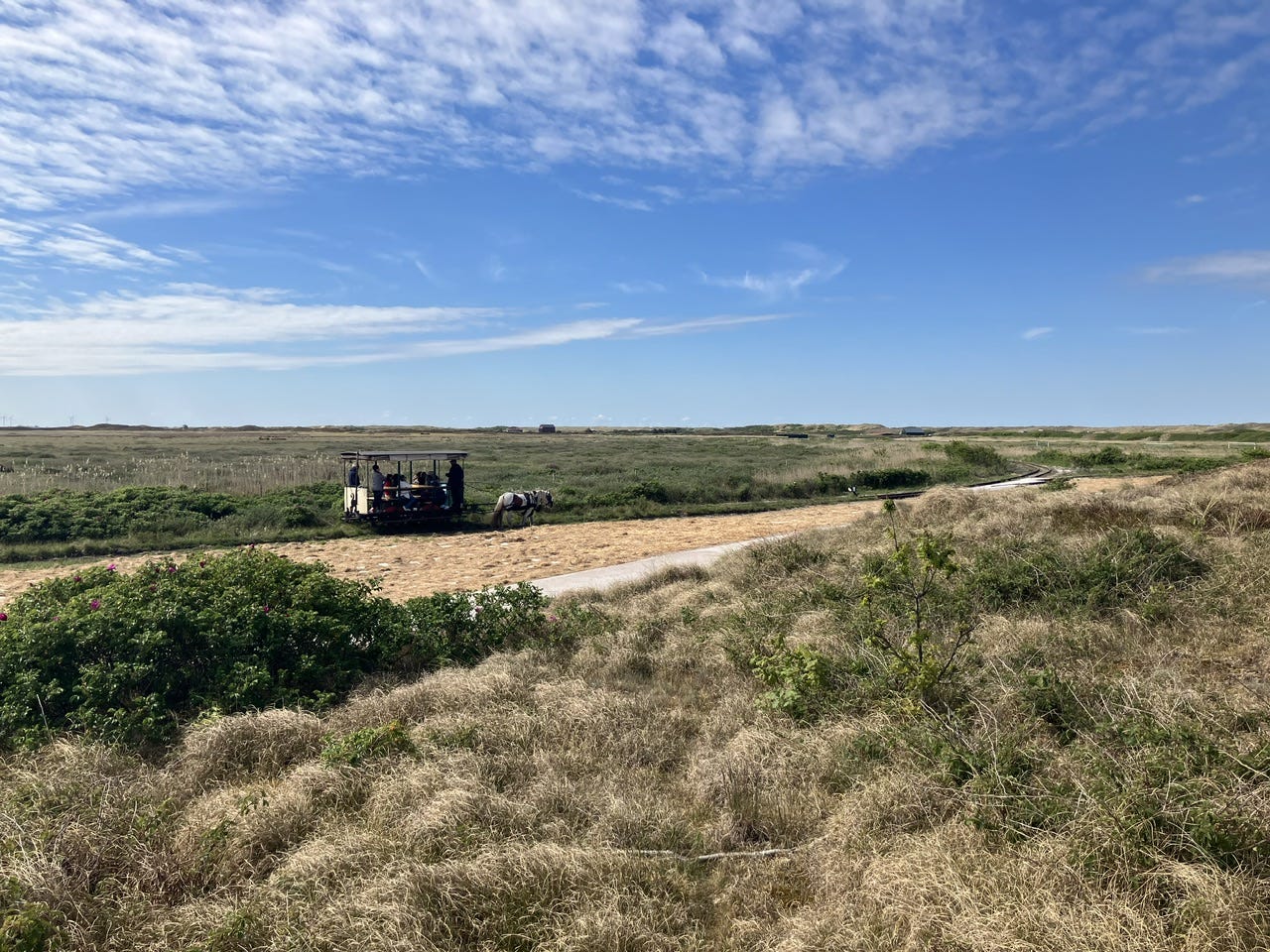This is the second installment of the Stars Without Cars series. On the surface, the series comprises a set of guides for would-be visitors to car-free and “car-lite” International Dark Sky Places. On a more abstract level, the examples constitute a “proof of possibility” that compact, active-transportation-friendly communites and dark-sky-friendly communities can exist as one and the same.
Spiekeroog: The Wadden Sea’s First Car-Free Dark Sky Place
The Wadden Sea World Heritage Site, which spans the coasts of the Netherlands, Germany and Denmark, is one of Europe’s hotspots for research and action related to light pollution. In 2019, the Trilateral Dark Sky Initiative was launched by a coalition of municipalities, NGOs, universities and research institutes spanning the three countries. Among other activities, the initiative has published a fact sheet and longer report on the importance of darkness to the Wadden Sea, sponsored a variety of workshops and lectures on the subject of light pollution and the region’s dark sky heritage, and participated in the 2022 World Migratory Bird Day on the theme “Dim the lights for birds at night.”
Other research and advocacy efforts also span the Wadden Sea area, such as the EU-funded DARKER SKY project, which brings together universities, businesses and NGOs from Denmark, Germany, the Netherlands to promote better lighting practices to protect biodiversity and ecological connectivity in the North Sea.
The Wadden Sea region also happens to host one of the world’s highest concentrations of car-free islands: five out of seven of Germany’s East Frisian Islands (Juist, Baltrum, Langeoog, Spiekeroog and Wangerooge) ban personal motor vehicles. In addition, two of the Netherlands’ West Frisian Islands (Vlieland and Schiermonnikoog) are largely car-free, permitting only permanent residents to have and use cars on the islands (see the first Honorable Mention below). Most other Wadden islands can also be reached without use of a personal automobile and easily explored on foot or bike.
Although other East Frisian Islands have also demonstrated a commitment to control light pollution (e.g. Wangerooge has participated in the regional project Sternenfunkeln über Friesland and Dark Sky Week), Spiekeroog is the first (and so far only) to become certified by DarkSky International as an official IDSP. Much of the 18.3 km² island consists of protected dunes and salt marshes, and is thus streetlight-free. Furthermore, the streetlights in the charming “downtown” are notable in their wide-spaced positioning, and the harbour lighting is well-directed and low CCT. Spiekeroog also excels in providing interpretation boards (in German) to educate visitors about the importance and quality of the night sky.
One nice touch that I discovered was a stargazing spot with its own built-in public reclining chairs. Granted, I myself visited the island in May, and I was typically in bed before any suitable stargazing opportunities arose.
Getting There
As long as you are able to reach an international airport, there is no need to drive at any point on your journey to visit car-free Spiekeroog (and, conversely, if you live on Spiekeroog, there is no need to hire a car to leave the island and travel the world).
If you don’t have a private boat, the only way to reach Spiekeroog is by ferry from the fishing village of Neuharlingersiel. Tickets can be purchased at the port, but if you are like me, you prefer to book all of your transit connections ahead of time, even if it requires a foreign bank transfer. The online booking portal for “Fährtickets” can be found on the Spiekeroog.de site (only available in German). The booking process is easy, but as of April 2025 it does not permit credit card payments; instead, the booking confirmation provides the details of a bank account to which the balance needs to be transferred. If you don’t have a German bank account and are not used to making international transfers, keep in mind that many banks charge hefty fees for such transactions — if they offer the service at all — and some popular services for international bank transfers (e.g. PayPal’s Xoom) will not process transfers to business accounts. I personally used Xe when I booked my sailing to Spiekeroog; it was a little slow but ultimately worked without a hitch.
As far as reaching the port in Neuharlingersiel, there are several car-free options:
• The most direct route for most international travellers is probably to take a train to the Bremen Hauptbahnhof (e.g. from Hamburg) and then walk a block or two to the bus stands to catch the Ostfriesland Express — a non-stop route from Bremen to the ferries to Langeoog, Spiekeroog and Wangerooge (and back again). Tickets can be purchased online (via credit card!) and either printed or saved on a mobile device. The Ostfriesland Express timetables don’t seem to perfectly align to the ferry times, but the ferry terminal provides WiFi, a small café and lockers to stow your belongings while exploring Neuharlingersiel.
• Those who want to explore more of Germany’s Wadden Sea area – including additional car-free islands – might be interested in the K1 and K2 bus lines (see the timetables here). The K1 line from Neuharlingersiel goes as far as Norden, the gateway to car-free Juist. The K2 line stops at Esens Bahnhof, where you can take a connecting train to the Wadden Sea port city of Wilhelmshaven. From there, if you like, you can take the ferry to tiny Helgoland, Germany’s only island of the high seas, which also happens to be car-free.
Amenities
Spiekeroog’s charming town has no shortage of stores and restaurants — it wouldn’t surprise me in the least if some visitors come to the island merely to dine and shop. For the latest opening hours, you can check the list of businesses at Spiekeroog.de.
Even more importantly for the self-catering visitor, or the lucky permanent resident, there are a couple of fine grocery stores: Grüner Inselmarkt is one of the largest small-island shops I have ever encountered, while Watt’n Koophuus is smaller but also well stocked, with an emphasis on local/regional and organic products. In addition, the Inselbäckerei offers many tasty homemade baked goods, and Inselwinkel sells local liquors/liqueurs and other local artisanal products. Meanwhile, out in the dunes, Liekedeler’s Kuurhuus is one of the top small-island cocktail bars I have visited — the kind that would be worth visiting for the drinks and atmosphere even if it weren’t in its serene and isolated setting — and also sells its own spirits (unfortunately I have not spent enough time on Spiekeroog to try as many as I would like).
Spiekeroog also has a doctor (Inselpraxis Spiekeroog), pharmacy (Insel Apotheke), bank with ATM (Raiffeisen-Volksbank), multiple clothing stores and more… I haven’t personally stayed on the island for longer than a week, but a prolonged stay would hardly be a hardship; the island is easily the most well equipped on the list (which might come as little surprise, given that it is both the most populous and the closest to the mainland). One thing that I did not notice was a coffee shop that appeared oriented to us antisocial folks who like to stay glued to our laptops and tablets — but, then, it is easy to find holiday apartments with WiFi, so we simply must content ourselves with being antisocial and tech-addicted in the privacy of our holiday homes.
Accommodations
There are a wide variety of accommodation options on Spiekeroog, including a selection of one-bedroom self-catering apartments (woot!). Although some can be found via sites like Booking.com and Airbnb, you will discover the best selection at Spiekeroog.de's booking page, which has filtering capabilities on par with the former sites, and even the option to search in English.
Note, however, that the island’s booking page is a search tool only: you will complete the transaction directly with the property owner, which is very likely to require an international bank transfer (unless you happen to have a German bank account, of course, in which case it will just be an ordinary domestic transfer). But, then, if you are headed to Spiekeroog, you will need to be comfortable transfering money to German bank accounts to purchase the ferry tickets, as mentioned above. It is also almost certain that the apartment terms and conditions will be only available in German, so be sure to have a translation app at hand if you do not read the language.
Getting Around
There is no place on Spiekeroog to hire a bike, nor are there buses, but the “city” is extremely compact and walkable, and even the outer reaches of the dunes and salt marshes are accessible via a good hike. Carts are provided for hauling luggage to and from the harbour, with each holiday property generally providing its own cart or carts.
Oh, there is a very cute railway line through the west of Spiekeroog which has been repurposed for horse-drawn carriage rides as the “Pferdebahn.” I have not used the Pferdebahn myself, but I think it is for guided tours rather than transportation.
Did you find this post useful or informative? Consider buying me a coffee on Ko-Fi. Any writing that I post here will always be free to the public without paywalls or paid subscriptions, but I appreciate any contributions; your voluntary support will help me keep at this.
Follow me on Bluesky.

